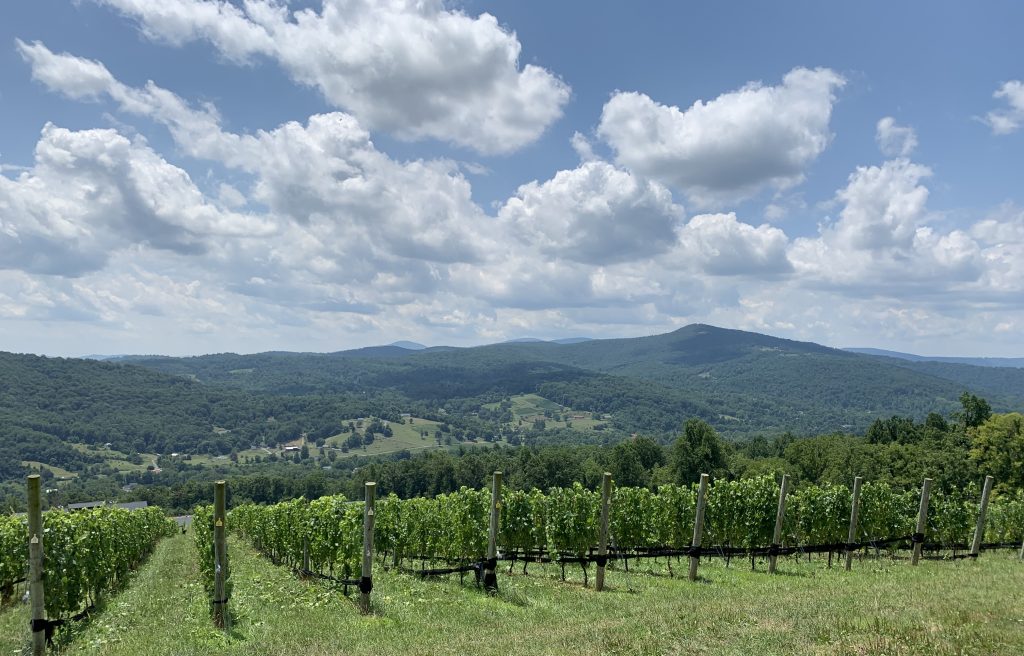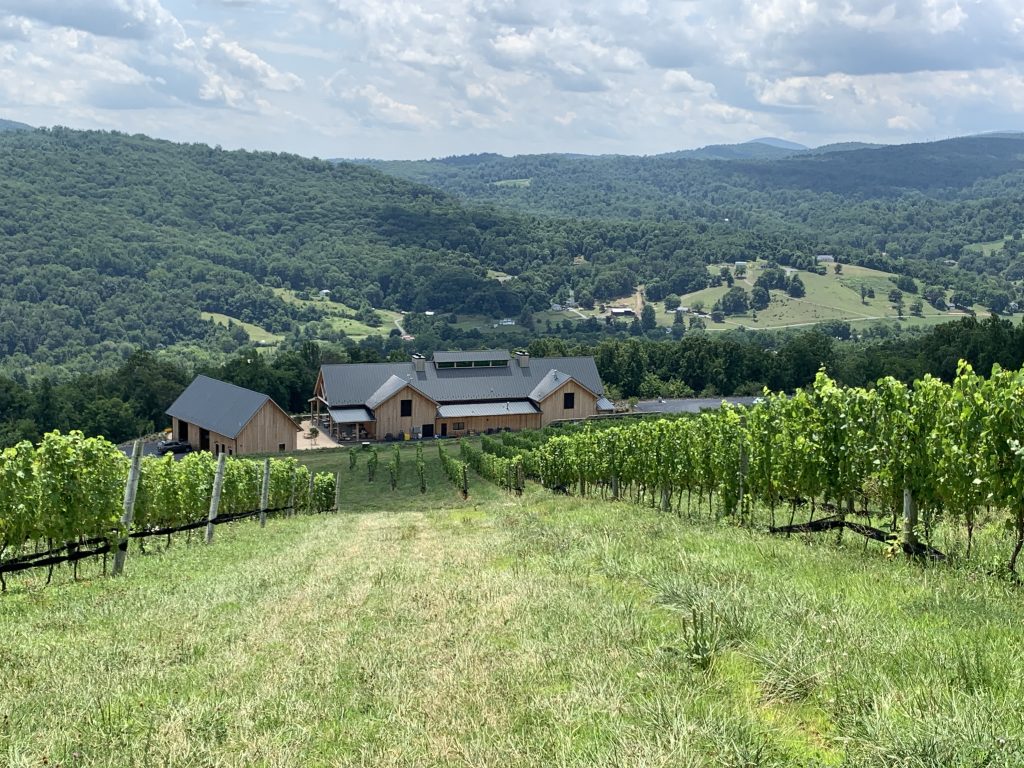The Delaplane area near I-66 as it passes through the Blue Ridge Mountains has acquired quite a cluster of notable wineries, chief among them Linden Vineyards and RdV Vineyards. Since it opened in March, Crimson Lane should now be added to that list.

Located off Freezeland Rd. and I-66 below neighboring Fox Meadow Vineyards, Crimson Lane was first planted to winegrapes in 2016, yielding its first full vintage in the excellent 2019 vintage. The site is enviable, with regular ambient winds coming through the gap in the mountains; vineyard elevation ranges from 940-1450 feet, with a southeastern aspect, and the winery only produces estate-bottled wines.
Founder Tom Herrity is realizing his long-time dream of finding an exceptional site, producing great wine and also memorable experiences for visitors. Crimson Lane opened this last March and is a family affair; Tom’s wife and co-owner Deanna is the interior designer, and her brother Dominick Fioresi, who interned at Linden Vineyards under Jim Law, is the winemaker, and has also worked at Delaplane Cellars and Ingleside Vineyards.

Three Memorable Impressions
The first impression you get, reaching the tasting room parking lot, is a “Sound of Music”-like panorama of the Blue Ridge and its nearby foothills; the second is just as impressive; rows of healthy, closely spaced vines cascading down from the summit at what seems to be a 30-degree slope. The third impression is the tasting room building, the first on the East Coast designed by the Napa-based firm of Backen & Backen.
Crimson Lane’s viticulturist is the renowned ampelographer Lucie Morton (based in Charlottesville), and Stephen Blais, a member of the Michelle Rolland consulting group, is consulting enologist.

The tasting room design is spacious and elegant, with lots of air and light, with naturally light wood. The Herrity’s put an emphasis on the customer experience, and on benefits of their club membership, the “Crimson Club.” There are two private tasting rooms for club members, a general tasting room for club members, and events exclusively for club members (there are no public events or weddings, etc.) Various public tasting areas include seating at tables, at a tasting bar, or covered porch areas with breathtaking views of the valley below (you can see Avenius Vineyard, a supplier to Linden Vineyards, at the top of the next ridge over).
All tasting room visitors must make an appointment through their website; https://crimsonlanevineyards.com/visit/
Crimson Lane’s Wines
Crimson Lane’s current product line includes five whites and four reds. The whites are: Albariño, Sauvignon Blanc, two Chardonnays (stainless and barrel-aged), and a semi-dry Petit Manseng. The reds are two Meritage-style blends (“Collina,” a blend of Merlot, Cabernet Franc and Cabernet Sauvignon, and “Parral”, a blend of whichever top quality barrels the vintage presents), and a varietal Petit Verdot. Crimson Lane currently producing 2100 cases from just under 200 acres, they plan to plateau production at 5,000 cases.
Crimson Lane Tasting Notes
***Albariño ’21: Nose: racy lime, passion fruit and mineral notes. Palate: Wow! BIG acidity AND citrus fruit; it’s all going on! Versatile, alive with energy, a great food wine. $38
***Sauvignon Blanc ’20: First vintage from these vines. Nose: rich but subtle, Loire Valley-like but not racy. Palate: intense fruit/acid balance, apple/pear flavors, Riesling-like but original with high quality, great food wine. $38
***+ Chardonnay ’19 (stainless): Nose: light, fresh, bright, hint of lemon. Palate: intense, like a proper Chablis; big Meyer lemon flavor and acidity, firm and long, impressively Burgundian style but no reduction. Note: Tom told me this bottle had been open for a day; brilliant.
***Chardonnay ’19 (barrel aged): 13 months in 30% new Hungarian and French oak, 50% full malolactic fermentation. Nose: intriguing hint of “paprika” from the Hungarian oak, hint of yeast and lemon. Rich, viscous texture, then powerful, BIG Meyer lemon flavor carries through to the finish. Rich but stylish.
**Petit Manseng ’22: The residual sugar for this wine is 4% (40 g/l) but it drinks as if it were half as much due to the high (natural) acidity of the grape. Nose: light, fresh, gently tropical fruit. Palate: bright fruit, firm acidity, very well-balanced, a crowd-pleaser and versatile now, but will benefit from a year or two of age.
***>*Callina ’19 (50% Merlot, 25% ea. Cabernet Franc, Cabernet Sauvignon).
Tom explains that he and Dominick taste every barrel of the red wines post-fermentation, and the best ones go to the “Parral” blend, regardless of the varietal portions. The rest go into the Callina blend (translated as “hill” in Italian), in what turned out to be a “Right Bank” style Bordeaux blend, but Tom points out that the blend ratio could be completely different in another vintage, and that “we always try to make the best wines we can possibly make.” Callina spent 24 months in 50% new oak. The color is opaque but with a crimson rim typical of the vintage. Nose: fresh, bright red fruits but with depth. Palate: at first, fruity and forward, then deep with rich, smooth tannins, and a sexy mocha finish. Fresh, integrated and balanced.
****Parral ’19: The premier red blend of Crimson Lane, made from the best barrels of Merlot and the two Cabernets, the blend for this vintage was 42% Merlot, 33% Cabernet Franc and 25% Cabernet Sauvignon. Nose: black fruits, ripe but elegant, with a hint of new oak. Palate: rich, intense, ripe spicy tannins; drinks more like a 2017 in style, but rich and elegant. Named for a town in Mexico where the vineyard manager and his crew members come from, to honor their contribution to the wines of Crimson Lane. Worth laying down until 2029, or longer.
****Petit Verdot ’19: Tom explains that he tried to blend the Petit Verdot into the Meritage-style blends, but as neighbor Jim Law of Linden discovered, on these low-vigor mountain sites, the fruit was too intense and overwhelmed the blend. Accordingly, this is the only varietal red wine of Crimson Lane.
What makes it unique in Virginia is the use of two clones; the “masculine” clone 400 which is half of the blend, and that’s the dominant clone in Virginia, but the other half is clone 1058, which Tom says makes a more fragrant, fruity and “feminine” style. The two styles are both evident here, but in a finely balanced way, as if they are dancing a tango across your palate! Nose: (typical) high alcohol but rich, ripe black fruits. Palate: intense, BUT rich, ripe fruit with very smooth tannins; an impressive blend of these two styles of clones and a must for any fan of fine Virginia Petit Verdot.
For more information, visit https://crimsonlanevineyards.com/.
Ratings key: * = good, ** = very good, *** = classic style and quality, **** = exceptional, outstanding, + = given rating plus, > = will increase in quality with time.
